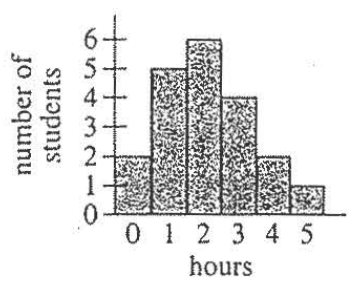(59.)
(60.) ACT A survey in a study skills class asked the 20 students enrolled in the class how many
hours
(rounded to the nearest hour) they has spent studying on the previous evening.
The 20 responses are summarized by the histogram below.

What fraction of the students responded that they had spent less than 3 hours studying?
$ A.\;\; \dfrac{13}{100} \\[5ex] B.\;\; \dfrac{1}{5} \\[5ex] C.\;\; \dfrac{3}{10} \\[5ex] D.\;\; \dfrac{13}{20} \\[5ex] E.\;\; \dfrac{17}{20} \\[5ex] $
$ Total\;\;number\;\;of\;\;students = whole = 20 \\[3ex] \underline{Less\;\;than\;\;3\;\;hours} \\[3ex] 0\;hour \rightarrow 2\;\;students \\[3ex] 1\;\;hour \rightarrow 5\;\;students \\[3ex] 2\;hours \rightarrow 6\;\;students \\[3ex] Number\;\;of\;\;students = part = 2 + 5 + 6 = 13 \\[3ex] Fraction\;\;of\;\;students = \dfrac{part}{whole} = \dfrac{13}{20} $
The 20 responses are summarized by the histogram below.

What fraction of the students responded that they had spent less than 3 hours studying?
$ A.\;\; \dfrac{13}{100} \\[5ex] B.\;\; \dfrac{1}{5} \\[5ex] C.\;\; \dfrac{3}{10} \\[5ex] D.\;\; \dfrac{13}{20} \\[5ex] E.\;\; \dfrac{17}{20} \\[5ex] $
$ Total\;\;number\;\;of\;\;students = whole = 20 \\[3ex] \underline{Less\;\;than\;\;3\;\;hours} \\[3ex] 0\;hour \rightarrow 2\;\;students \\[3ex] 1\;\;hour \rightarrow 5\;\;students \\[3ex] 2\;hours \rightarrow 6\;\;students \\[3ex] Number\;\;of\;\;students = part = 2 + 5 + 6 = 13 \\[3ex] Fraction\;\;of\;\;students = \dfrac{part}{whole} = \dfrac{13}{20} $